Change Management Report: Leadership, Resistance, and Strategies
VerifiedAdded on 2022/09/15
|11
|2870
|18
Report
AI Summary
This report analyzes five articles focused on organizational change management. The first article emphasizes the role of leadership in managing resistance to change, highlighting the importance of effective leadership and team harmony. The second article explores emerging organizational paramet...
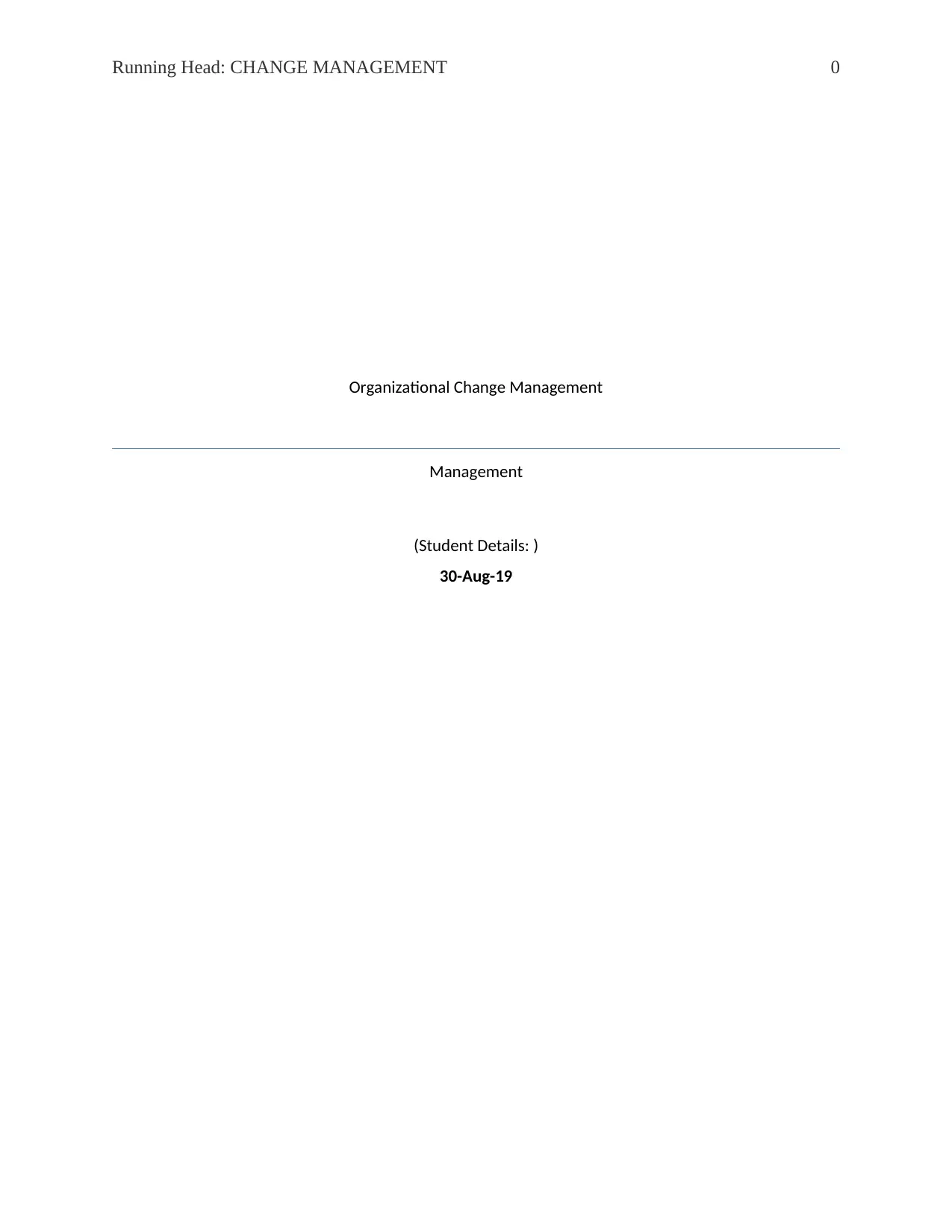
Running Head: CHANGE MANAGEMENT 0
Organizational Change Management
Management
(Student Details: )
30-Aug-19
Organizational Change Management
Management
(Student Details: )
30-Aug-19
Paraphrase This Document
Need a fresh take? Get an instant paraphrase of this document with our AI Paraphraser
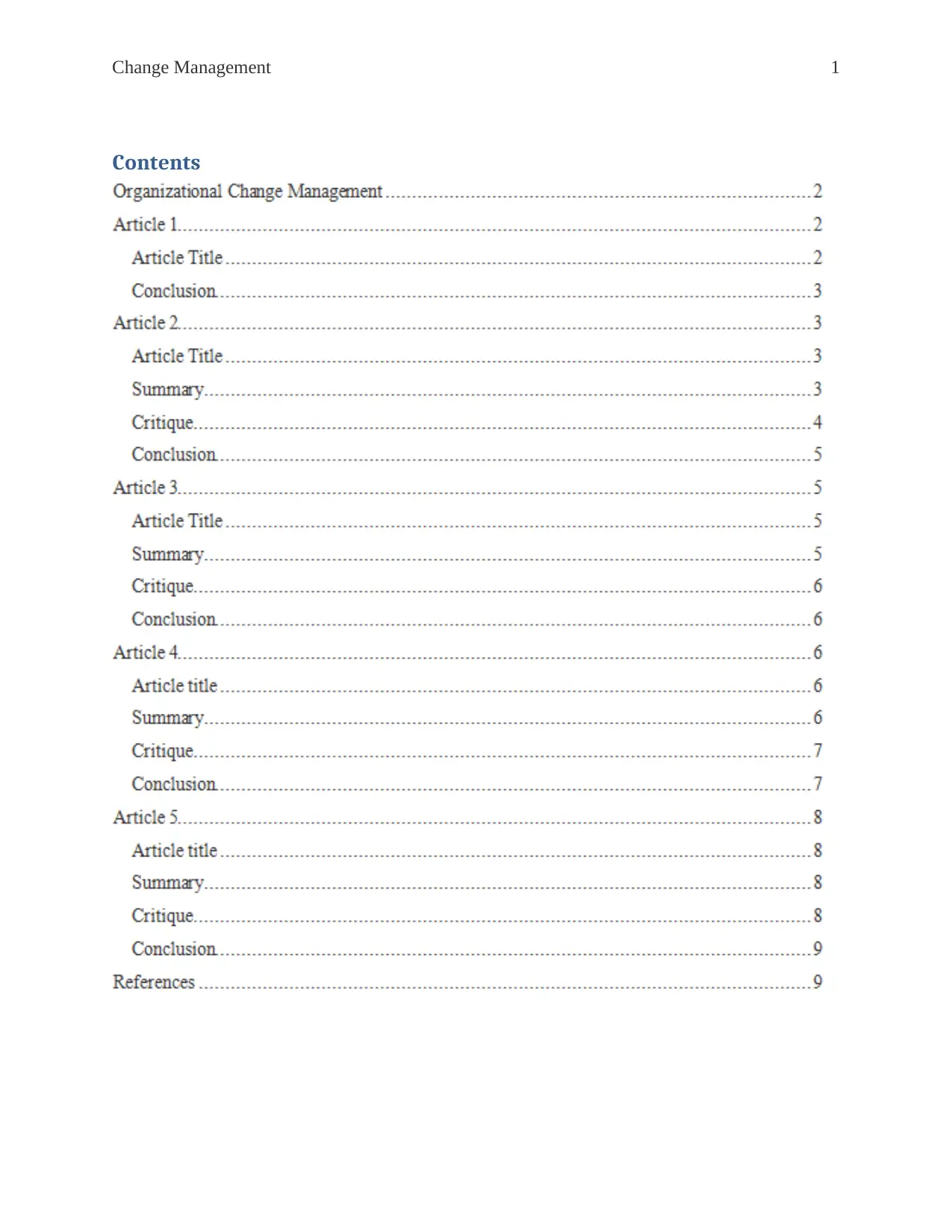
Change Management 1
Contents
Contents
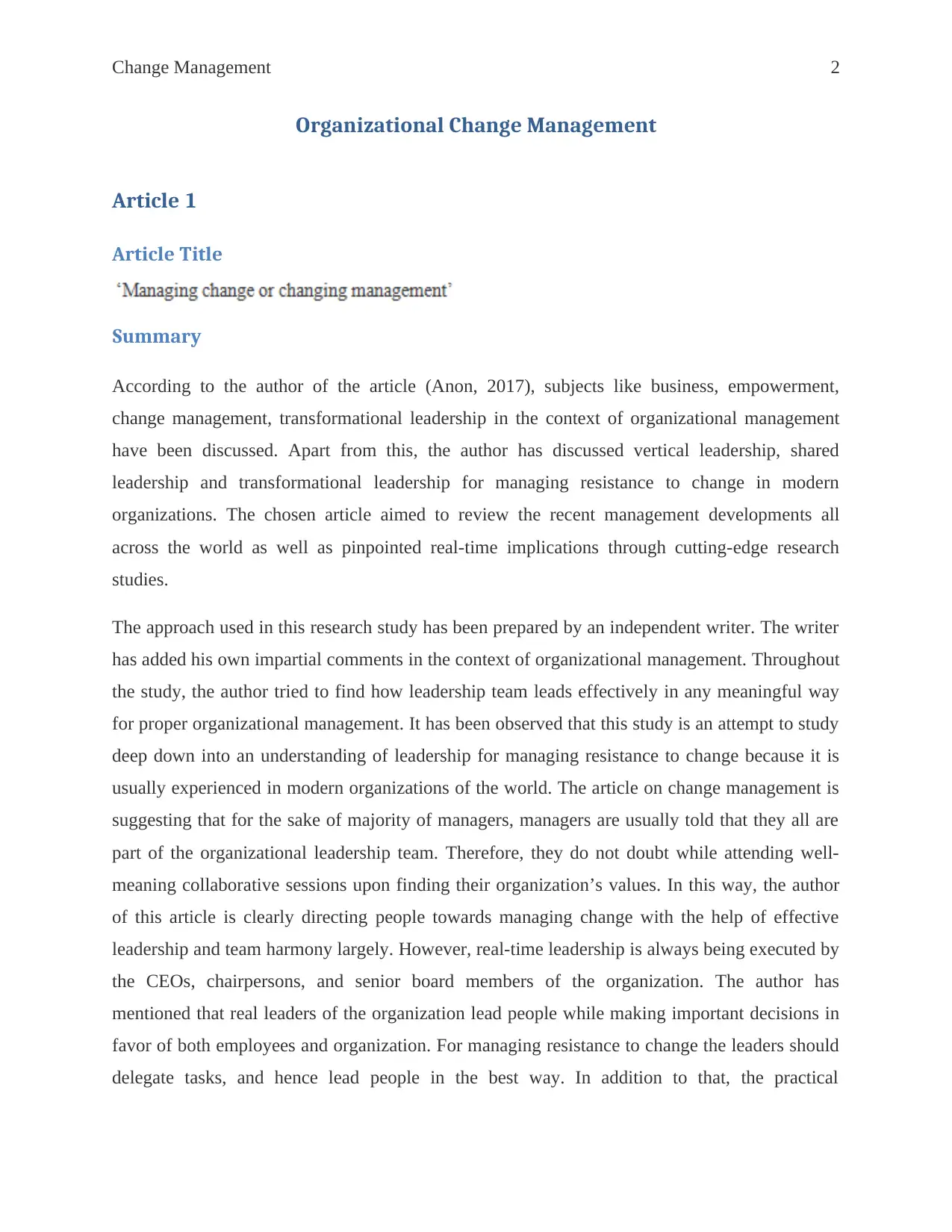
Change Management 2
Organizational Change Management
Article 1
Article Title
Summary
According to the author of the article (Anon, 2017), subjects like business, empowerment,
change management, transformational leadership in the context of organizational management
have been discussed. Apart from this, the author has discussed vertical leadership, shared
leadership and transformational leadership for managing resistance to change in modern
organizations. The chosen article aimed to review the recent management developments all
across the world as well as pinpointed real-time implications through cutting-edge research
studies.
The approach used in this research study has been prepared by an independent writer. The writer
has added his own impartial comments in the context of organizational management. Throughout
the study, the author tried to find how leadership team leads effectively in any meaningful way
for proper organizational management. It has been observed that this study is an attempt to study
deep down into an understanding of leadership for managing resistance to change because it is
usually experienced in modern organizations of the world. The article on change management is
suggesting that for the sake of majority of managers, managers are usually told that they all are
part of the organizational leadership team. Therefore, they do not doubt while attending well-
meaning collaborative sessions upon finding their organization’s values. In this way, the author
of this article is clearly directing people towards managing change with the help of effective
leadership and team harmony largely. However, real-time leadership is always being executed by
the CEOs, chairpersons, and senior board members of the organization. The author has
mentioned that real leaders of the organization lead people while making important decisions in
favor of both employees and organization. For managing resistance to change the leaders should
delegate tasks, and hence lead people in the best way. In addition to that, the practical
Organizational Change Management
Article 1
Article Title
Summary
According to the author of the article (Anon, 2017), subjects like business, empowerment,
change management, transformational leadership in the context of organizational management
have been discussed. Apart from this, the author has discussed vertical leadership, shared
leadership and transformational leadership for managing resistance to change in modern
organizations. The chosen article aimed to review the recent management developments all
across the world as well as pinpointed real-time implications through cutting-edge research
studies.
The approach used in this research study has been prepared by an independent writer. The writer
has added his own impartial comments in the context of organizational management. Throughout
the study, the author tried to find how leadership team leads effectively in any meaningful way
for proper organizational management. It has been observed that this study is an attempt to study
deep down into an understanding of leadership for managing resistance to change because it is
usually experienced in modern organizations of the world. The article on change management is
suggesting that for the sake of majority of managers, managers are usually told that they all are
part of the organizational leadership team. Therefore, they do not doubt while attending well-
meaning collaborative sessions upon finding their organization’s values. In this way, the author
of this article is clearly directing people towards managing change with the help of effective
leadership and team harmony largely. However, real-time leadership is always being executed by
the CEOs, chairpersons, and senior board members of the organization. The author has
mentioned that real leaders of the organization lead people while making important decisions in
favor of both employees and organization. For managing resistance to change the leaders should
delegate tasks, and hence lead people in the best way. In addition to that, the practical
You're viewing a preview
Unlock full access by subscribing today!
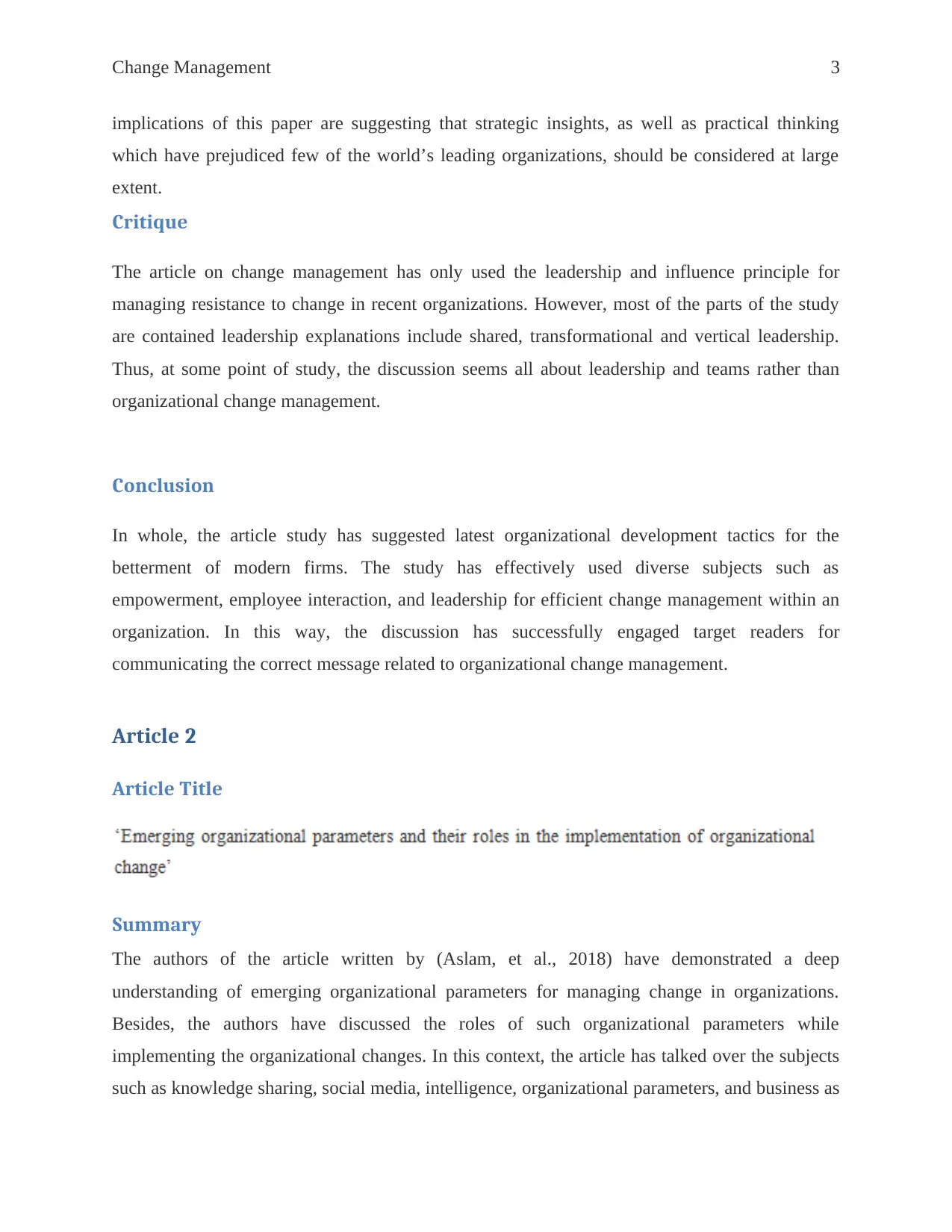
Change Management 3
implications of this paper are suggesting that strategic insights, as well as practical thinking
which have prejudiced few of the world’s leading organizations, should be considered at large
extent.
Critique
The article on change management has only used the leadership and influence principle for
managing resistance to change in recent organizations. However, most of the parts of the study
are contained leadership explanations include shared, transformational and vertical leadership.
Thus, at some point of study, the discussion seems all about leadership and teams rather than
organizational change management.
Conclusion
In whole, the article study has suggested latest organizational development tactics for the
betterment of modern firms. The study has effectively used diverse subjects such as
empowerment, employee interaction, and leadership for efficient change management within an
organization. In this way, the discussion has successfully engaged target readers for
communicating the correct message related to organizational change management.
Article 2
Article Title
Summary
The authors of the article written by (Aslam, et al., 2018) have demonstrated a deep
understanding of emerging organizational parameters for managing change in organizations.
Besides, the authors have discussed the roles of such organizational parameters while
implementing the organizational changes. In this context, the article has talked over the subjects
such as knowledge sharing, social media, intelligence, organizational parameters, and business as
implications of this paper are suggesting that strategic insights, as well as practical thinking
which have prejudiced few of the world’s leading organizations, should be considered at large
extent.
Critique
The article on change management has only used the leadership and influence principle for
managing resistance to change in recent organizations. However, most of the parts of the study
are contained leadership explanations include shared, transformational and vertical leadership.
Thus, at some point of study, the discussion seems all about leadership and teams rather than
organizational change management.
Conclusion
In whole, the article study has suggested latest organizational development tactics for the
betterment of modern firms. The study has effectively used diverse subjects such as
empowerment, employee interaction, and leadership for efficient change management within an
organization. In this way, the discussion has successfully engaged target readers for
communicating the correct message related to organizational change management.
Article 2
Article Title
Summary
The authors of the article written by (Aslam, et al., 2018) have demonstrated a deep
understanding of emerging organizational parameters for managing change in organizations.
Besides, the authors have discussed the roles of such organizational parameters while
implementing the organizational changes. In this context, the article has talked over the subjects
such as knowledge sharing, social media, intelligence, organizational parameters, and business as
Paraphrase This Document
Need a fresh take? Get an instant paraphrase of this document with our AI Paraphraser
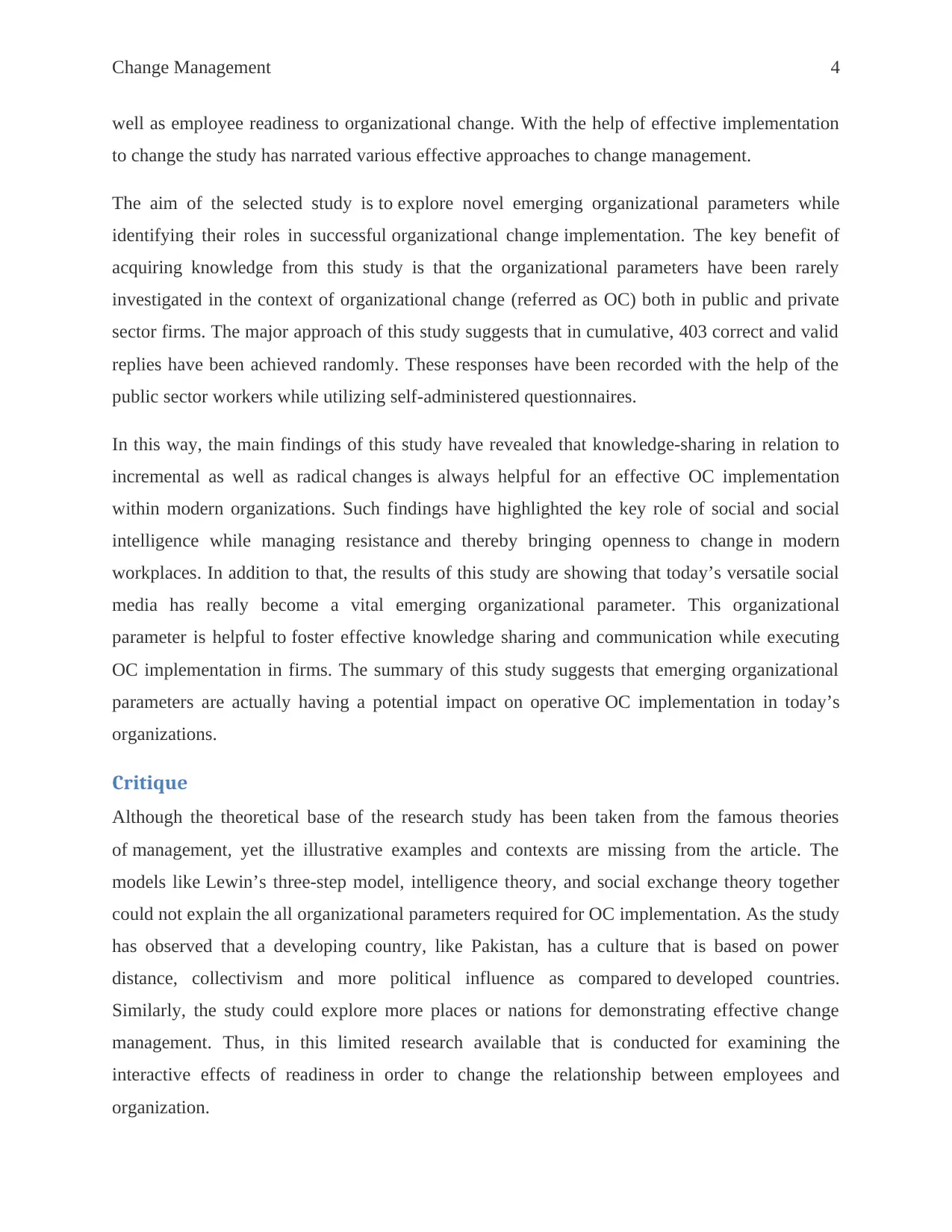
Change Management 4
well as employee readiness to organizational change. With the help of effective implementation
to change the study has narrated various effective approaches to change management.
The aim of the selected study is to explore novel emerging organizational parameters while
identifying their roles in successful organizational change implementation. The key benefit of
acquiring knowledge from this study is that the organizational parameters have been rarely
investigated in the context of organizational change (referred as OC) both in public and private
sector firms. The major approach of this study suggests that in cumulative, 403 correct and valid
replies have been achieved randomly. These responses have been recorded with the help of the
public sector workers while utilizing self-administered questionnaires.
In this way, the main findings of this study have revealed that knowledge-sharing in relation to
incremental as well as radical changes is always helpful for an effective OC implementation
within modern organizations. Such findings have highlighted the key role of social and social
intelligence while managing resistance and thereby bringing openness to change in modern
workplaces. In addition to that, the results of this study are showing that today’s versatile social
media has really become a vital emerging organizational parameter. This organizational
parameter is helpful to foster effective knowledge sharing and communication while executing
OC implementation in firms. The summary of this study suggests that emerging organizational
parameters are actually having a potential impact on operative OC implementation in today’s
organizations.
Critique
Although the theoretical base of the research study has been taken from the famous theories
of management, yet the illustrative examples and contexts are missing from the article. The
models like Lewin’s three-step model, intelligence theory, and social exchange theory together
could not explain the all organizational parameters required for OC implementation. As the study
has observed that a developing country, like Pakistan, has a culture that is based on power
distance, collectivism and more political influence as compared to developed countries.
Similarly, the study could explore more places or nations for demonstrating effective change
management. Thus, in this limited research available that is conducted for examining the
interactive effects of readiness in order to change the relationship between employees and
organization.
well as employee readiness to organizational change. With the help of effective implementation
to change the study has narrated various effective approaches to change management.
The aim of the selected study is to explore novel emerging organizational parameters while
identifying their roles in successful organizational change implementation. The key benefit of
acquiring knowledge from this study is that the organizational parameters have been rarely
investigated in the context of organizational change (referred as OC) both in public and private
sector firms. The major approach of this study suggests that in cumulative, 403 correct and valid
replies have been achieved randomly. These responses have been recorded with the help of the
public sector workers while utilizing self-administered questionnaires.
In this way, the main findings of this study have revealed that knowledge-sharing in relation to
incremental as well as radical changes is always helpful for an effective OC implementation
within modern organizations. Such findings have highlighted the key role of social and social
intelligence while managing resistance and thereby bringing openness to change in modern
workplaces. In addition to that, the results of this study are showing that today’s versatile social
media has really become a vital emerging organizational parameter. This organizational
parameter is helpful to foster effective knowledge sharing and communication while executing
OC implementation in firms. The summary of this study suggests that emerging organizational
parameters are actually having a potential impact on operative OC implementation in today’s
organizations.
Critique
Although the theoretical base of the research study has been taken from the famous theories
of management, yet the illustrative examples and contexts are missing from the article. The
models like Lewin’s three-step model, intelligence theory, and social exchange theory together
could not explain the all organizational parameters required for OC implementation. As the study
has observed that a developing country, like Pakistan, has a culture that is based on power
distance, collectivism and more political influence as compared to developed countries.
Similarly, the study could explore more places or nations for demonstrating effective change
management. Thus, in this limited research available that is conducted for examining the
interactive effects of readiness in order to change the relationship between employees and
organization.
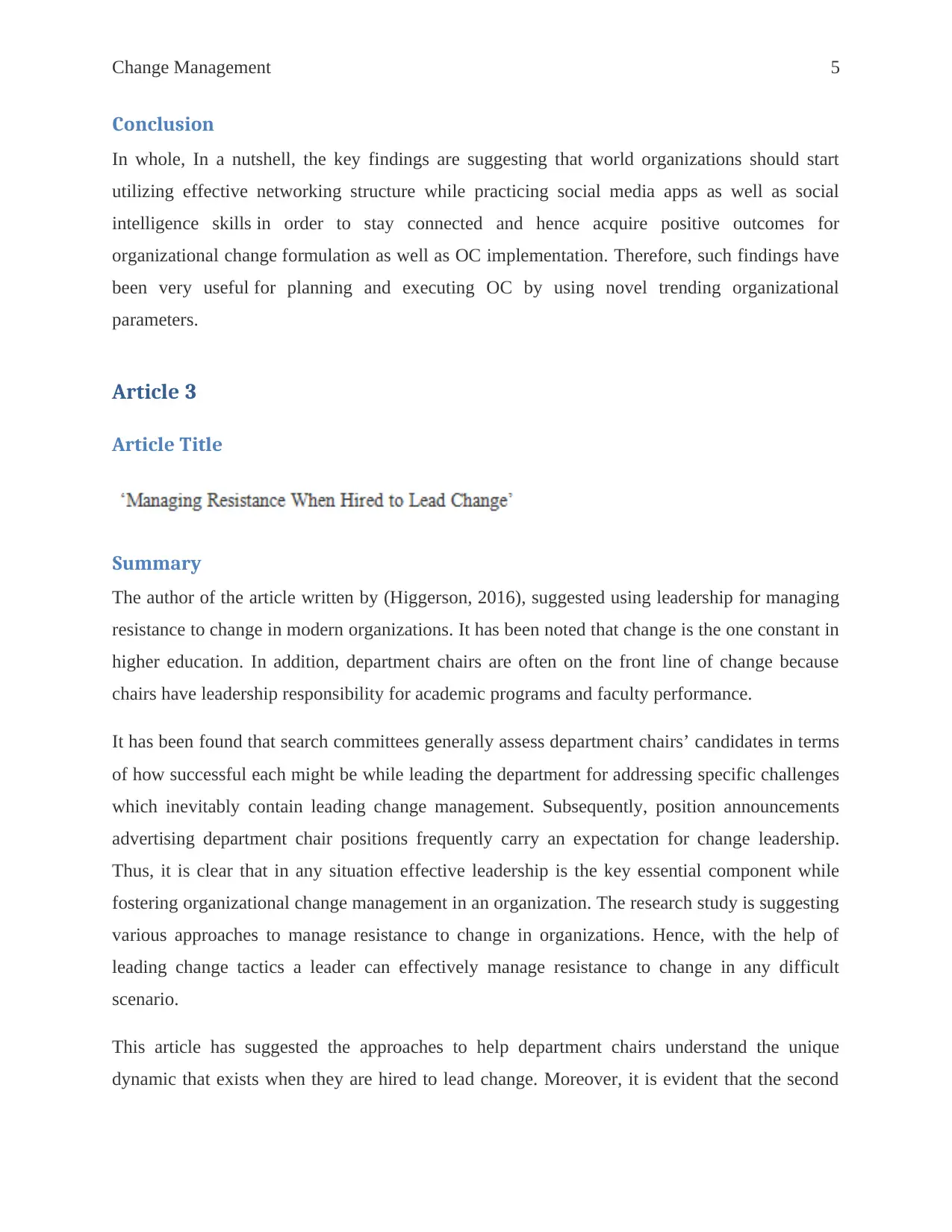
Change Management 5
Conclusion
In whole, In a nutshell, the key findings are suggesting that world organizations should start
utilizing effective networking structure while practicing social media apps as well as social
intelligence skills in order to stay connected and hence acquire positive outcomes for
organizational change formulation as well as OC implementation. Therefore, such findings have
been very useful for planning and executing OC by using novel trending organizational
parameters.
Article 3
Article Title
Summary
The author of the article written by (Higgerson, 2016), suggested using leadership for managing
resistance to change in modern organizations. It has been noted that change is the one constant in
higher education. In addition, department chairs are often on the front line of change because
chairs have leadership responsibility for academic programs and faculty performance.
It has been found that search committees generally assess department chairs’ candidates in terms
of how successful each might be while leading the department for addressing specific challenges
which inevitably contain leading change management. Subsequently, position announcements
advertising department chair positions frequently carry an expectation for change leadership.
Thus, it is clear that in any situation effective leadership is the key essential component while
fostering organizational change management in an organization. The research study is suggesting
various approaches to manage resistance to change in organizations. Hence, with the help of
leading change tactics a leader can effectively manage resistance to change in any difficult
scenario.
This article has suggested the approaches to help department chairs understand the unique
dynamic that exists when they are hired to lead change. Moreover, it is evident that the second
Conclusion
In whole, In a nutshell, the key findings are suggesting that world organizations should start
utilizing effective networking structure while practicing social media apps as well as social
intelligence skills in order to stay connected and hence acquire positive outcomes for
organizational change formulation as well as OC implementation. Therefore, such findings have
been very useful for planning and executing OC by using novel trending organizational
parameters.
Article 3
Article Title
Summary
The author of the article written by (Higgerson, 2016), suggested using leadership for managing
resistance to change in modern organizations. It has been noted that change is the one constant in
higher education. In addition, department chairs are often on the front line of change because
chairs have leadership responsibility for academic programs and faculty performance.
It has been found that search committees generally assess department chairs’ candidates in terms
of how successful each might be while leading the department for addressing specific challenges
which inevitably contain leading change management. Subsequently, position announcements
advertising department chair positions frequently carry an expectation for change leadership.
Thus, it is clear that in any situation effective leadership is the key essential component while
fostering organizational change management in an organization. The research study is suggesting
various approaches to manage resistance to change in organizations. Hence, with the help of
leading change tactics a leader can effectively manage resistance to change in any difficult
scenario.
This article has suggested the approaches to help department chairs understand the unique
dynamic that exists when they are hired to lead change. Moreover, it is evident that the second
You're viewing a preview
Unlock full access by subscribing today!
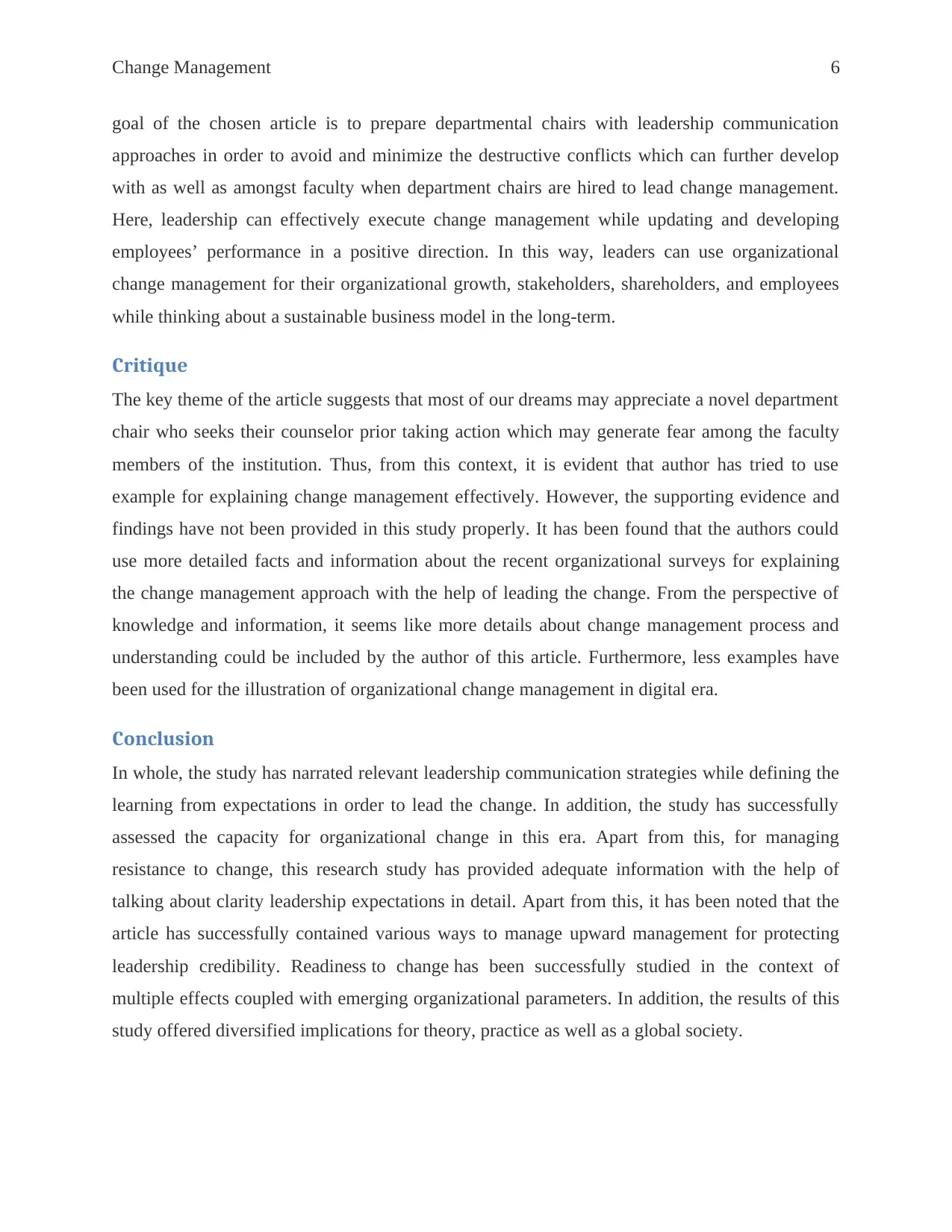
Change Management 6
goal of the chosen article is to prepare departmental chairs with leadership communication
approaches in order to avoid and minimize the destructive conflicts which can further develop
with as well as amongst faculty when department chairs are hired to lead change management.
Here, leadership can effectively execute change management while updating and developing
employees’ performance in a positive direction. In this way, leaders can use organizational
change management for their organizational growth, stakeholders, shareholders, and employees
while thinking about a sustainable business model in the long-term.
Critique
The key theme of the article suggests that most of our dreams may appreciate a novel department
chair who seeks their counselor prior taking action which may generate fear among the faculty
members of the institution. Thus, from this context, it is evident that author has tried to use
example for explaining change management effectively. However, the supporting evidence and
findings have not been provided in this study properly. It has been found that the authors could
use more detailed facts and information about the recent organizational surveys for explaining
the change management approach with the help of leading the change. From the perspective of
knowledge and information, it seems like more details about change management process and
understanding could be included by the author of this article. Furthermore, less examples have
been used for the illustration of organizational change management in digital era.
Conclusion
In whole, the study has narrated relevant leadership communication strategies while defining the
learning from expectations in order to lead the change. In addition, the study has successfully
assessed the capacity for organizational change in this era. Apart from this, for managing
resistance to change, this research study has provided adequate information with the help of
talking about clarity leadership expectations in detail. Apart from this, it has been noted that the
article has successfully contained various ways to manage upward management for protecting
leadership credibility. Readiness to change has been successfully studied in the context of
multiple effects coupled with emerging organizational parameters. In addition, the results of this
study offered diversified implications for theory, practice as well as a global society.
goal of the chosen article is to prepare departmental chairs with leadership communication
approaches in order to avoid and minimize the destructive conflicts which can further develop
with as well as amongst faculty when department chairs are hired to lead change management.
Here, leadership can effectively execute change management while updating and developing
employees’ performance in a positive direction. In this way, leaders can use organizational
change management for their organizational growth, stakeholders, shareholders, and employees
while thinking about a sustainable business model in the long-term.
Critique
The key theme of the article suggests that most of our dreams may appreciate a novel department
chair who seeks their counselor prior taking action which may generate fear among the faculty
members of the institution. Thus, from this context, it is evident that author has tried to use
example for explaining change management effectively. However, the supporting evidence and
findings have not been provided in this study properly. It has been found that the authors could
use more detailed facts and information about the recent organizational surveys for explaining
the change management approach with the help of leading the change. From the perspective of
knowledge and information, it seems like more details about change management process and
understanding could be included by the author of this article. Furthermore, less examples have
been used for the illustration of organizational change management in digital era.
Conclusion
In whole, the study has narrated relevant leadership communication strategies while defining the
learning from expectations in order to lead the change. In addition, the study has successfully
assessed the capacity for organizational change in this era. Apart from this, for managing
resistance to change, this research study has provided adequate information with the help of
talking about clarity leadership expectations in detail. Apart from this, it has been noted that the
article has successfully contained various ways to manage upward management for protecting
leadership credibility. Readiness to change has been successfully studied in the context of
multiple effects coupled with emerging organizational parameters. In addition, the results of this
study offered diversified implications for theory, practice as well as a global society.
Paraphrase This Document
Need a fresh take? Get an instant paraphrase of this document with our AI Paraphraser
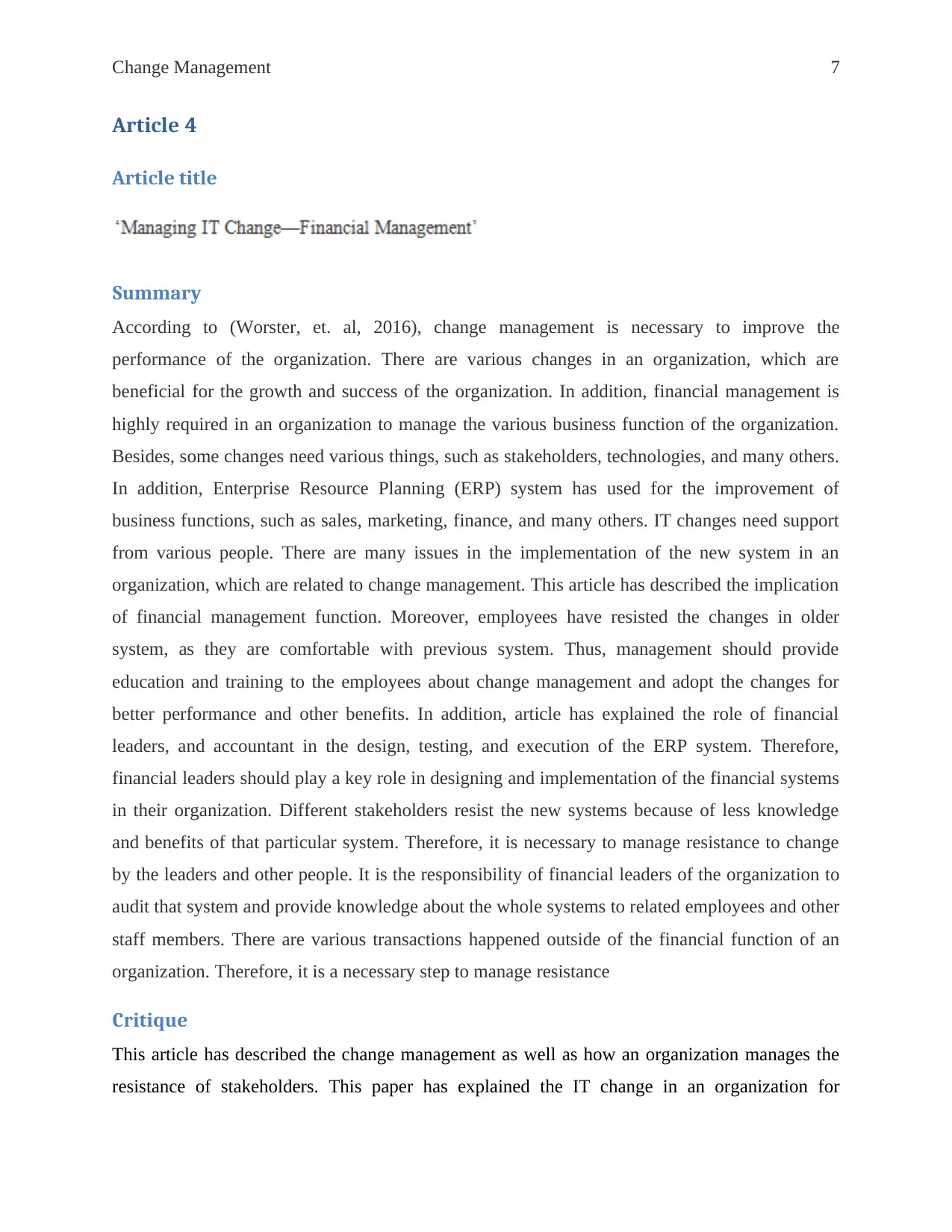
Change Management 7
Article 4
Article title
Summary
According to (Worster, et. al, 2016), change management is necessary to improve the
performance of the organization. There are various changes in an organization, which are
beneficial for the growth and success of the organization. In addition, financial management is
highly required in an organization to manage the various business function of the organization.
Besides, some changes need various things, such as stakeholders, technologies, and many others.
In addition, Enterprise Resource Planning (ERP) system has used for the improvement of
business functions, such as sales, marketing, finance, and many others. IT changes need support
from various people. There are many issues in the implementation of the new system in an
organization, which are related to change management. This article has described the implication
of financial management function. Moreover, employees have resisted the changes in older
system, as they are comfortable with previous system. Thus, management should provide
education and training to the employees about change management and adopt the changes for
better performance and other benefits. In addition, article has explained the role of financial
leaders, and accountant in the design, testing, and execution of the ERP system. Therefore,
financial leaders should play a key role in designing and implementation of the financial systems
in their organization. Different stakeholders resist the new systems because of less knowledge
and benefits of that particular system. Therefore, it is necessary to manage resistance to change
by the leaders and other people. It is the responsibility of financial leaders of the organization to
audit that system and provide knowledge about the whole systems to related employees and other
staff members. There are various transactions happened outside of the financial function of an
organization. Therefore, it is a necessary step to manage resistance
Critique
This article has described the change management as well as how an organization manages the
resistance of stakeholders. This paper has explained the IT change in an organization for
Article 4
Article title
Summary
According to (Worster, et. al, 2016), change management is necessary to improve the
performance of the organization. There are various changes in an organization, which are
beneficial for the growth and success of the organization. In addition, financial management is
highly required in an organization to manage the various business function of the organization.
Besides, some changes need various things, such as stakeholders, technologies, and many others.
In addition, Enterprise Resource Planning (ERP) system has used for the improvement of
business functions, such as sales, marketing, finance, and many others. IT changes need support
from various people. There are many issues in the implementation of the new system in an
organization, which are related to change management. This article has described the implication
of financial management function. Moreover, employees have resisted the changes in older
system, as they are comfortable with previous system. Thus, management should provide
education and training to the employees about change management and adopt the changes for
better performance and other benefits. In addition, article has explained the role of financial
leaders, and accountant in the design, testing, and execution of the ERP system. Therefore,
financial leaders should play a key role in designing and implementation of the financial systems
in their organization. Different stakeholders resist the new systems because of less knowledge
and benefits of that particular system. Therefore, it is necessary to manage resistance to change
by the leaders and other people. It is the responsibility of financial leaders of the organization to
audit that system and provide knowledge about the whole systems to related employees and other
staff members. There are various transactions happened outside of the financial function of an
organization. Therefore, it is a necessary step to manage resistance
Critique
This article has described the change management as well as how an organization manages the
resistance of stakeholders. This paper has explained the IT change in an organization for
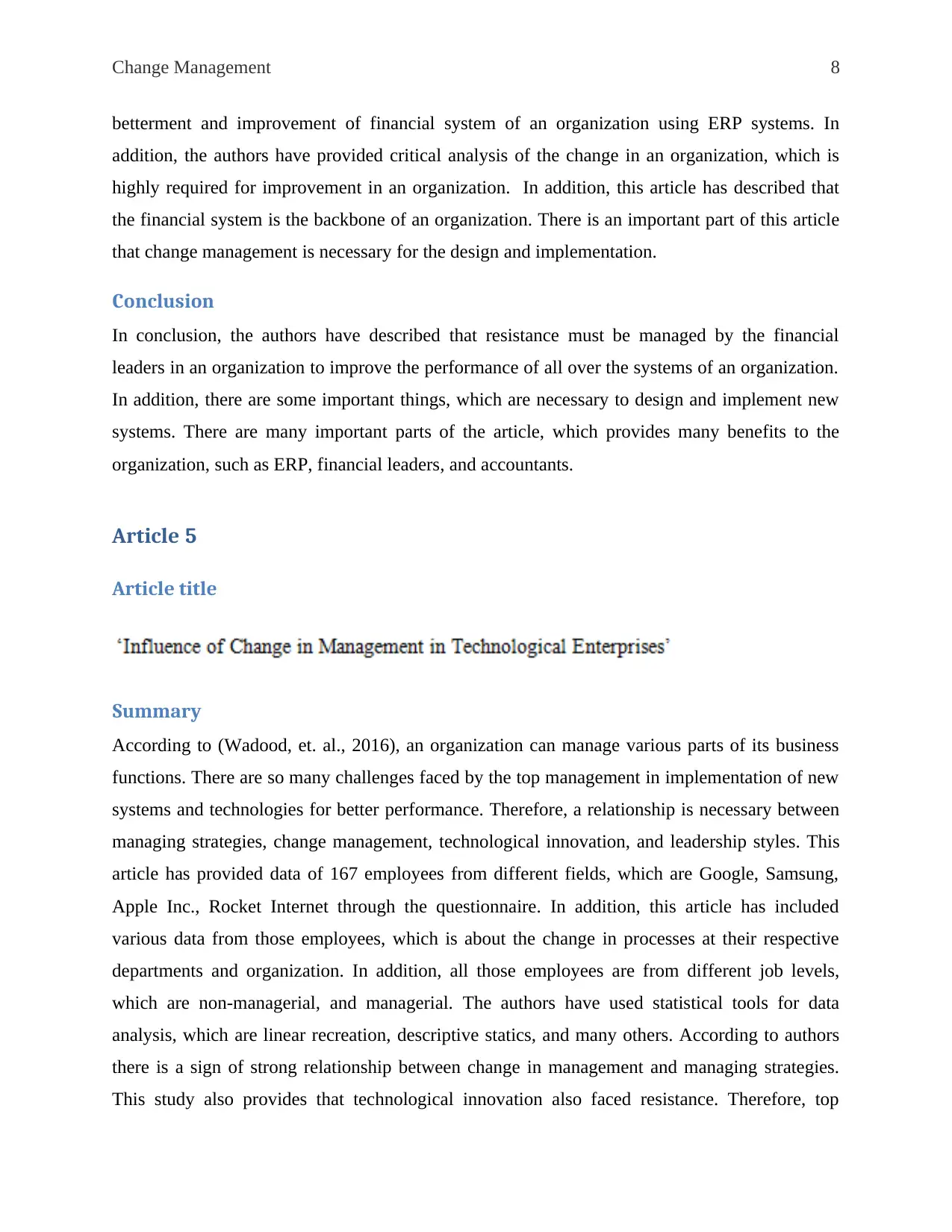
Change Management 8
betterment and improvement of financial system of an organization using ERP systems. In
addition, the authors have provided critical analysis of the change in an organization, which is
highly required for improvement in an organization. In addition, this article has described that
the financial system is the backbone of an organization. There is an important part of this article
that change management is necessary for the design and implementation.
Conclusion
In conclusion, the authors have described that resistance must be managed by the financial
leaders in an organization to improve the performance of all over the systems of an organization.
In addition, there are some important things, which are necessary to design and implement new
systems. There are many important parts of the article, which provides many benefits to the
organization, such as ERP, financial leaders, and accountants.
Article 5
Article title
Summary
According to (Wadood, et. al., 2016), an organization can manage various parts of its business
functions. There are so many challenges faced by the top management in implementation of new
systems and technologies for better performance. Therefore, a relationship is necessary between
managing strategies, change management, technological innovation, and leadership styles. This
article has provided data of 167 employees from different fields, which are Google, Samsung,
Apple Inc., Rocket Internet through the questionnaire. In addition, this article has included
various data from those employees, which is about the change in processes at their respective
departments and organization. In addition, all those employees are from different job levels,
which are non-managerial, and managerial. The authors have used statistical tools for data
analysis, which are linear recreation, descriptive statics, and many others. According to authors
there is a sign of strong relationship between change in management and managing strategies.
This study also provides that technological innovation also faced resistance. Therefore, top
betterment and improvement of financial system of an organization using ERP systems. In
addition, the authors have provided critical analysis of the change in an organization, which is
highly required for improvement in an organization. In addition, this article has described that
the financial system is the backbone of an organization. There is an important part of this article
that change management is necessary for the design and implementation.
Conclusion
In conclusion, the authors have described that resistance must be managed by the financial
leaders in an organization to improve the performance of all over the systems of an organization.
In addition, there are some important things, which are necessary to design and implement new
systems. There are many important parts of the article, which provides many benefits to the
organization, such as ERP, financial leaders, and accountants.
Article 5
Article title
Summary
According to (Wadood, et. al., 2016), an organization can manage various parts of its business
functions. There are so many challenges faced by the top management in implementation of new
systems and technologies for better performance. Therefore, a relationship is necessary between
managing strategies, change management, technological innovation, and leadership styles. This
article has provided data of 167 employees from different fields, which are Google, Samsung,
Apple Inc., Rocket Internet through the questionnaire. In addition, this article has included
various data from those employees, which is about the change in processes at their respective
departments and organization. In addition, all those employees are from different job levels,
which are non-managerial, and managerial. The authors have used statistical tools for data
analysis, which are linear recreation, descriptive statics, and many others. According to authors
there is a sign of strong relationship between change in management and managing strategies.
This study also provides that technological innovation also faced resistance. Therefore, top
You're viewing a preview
Unlock full access by subscribing today!
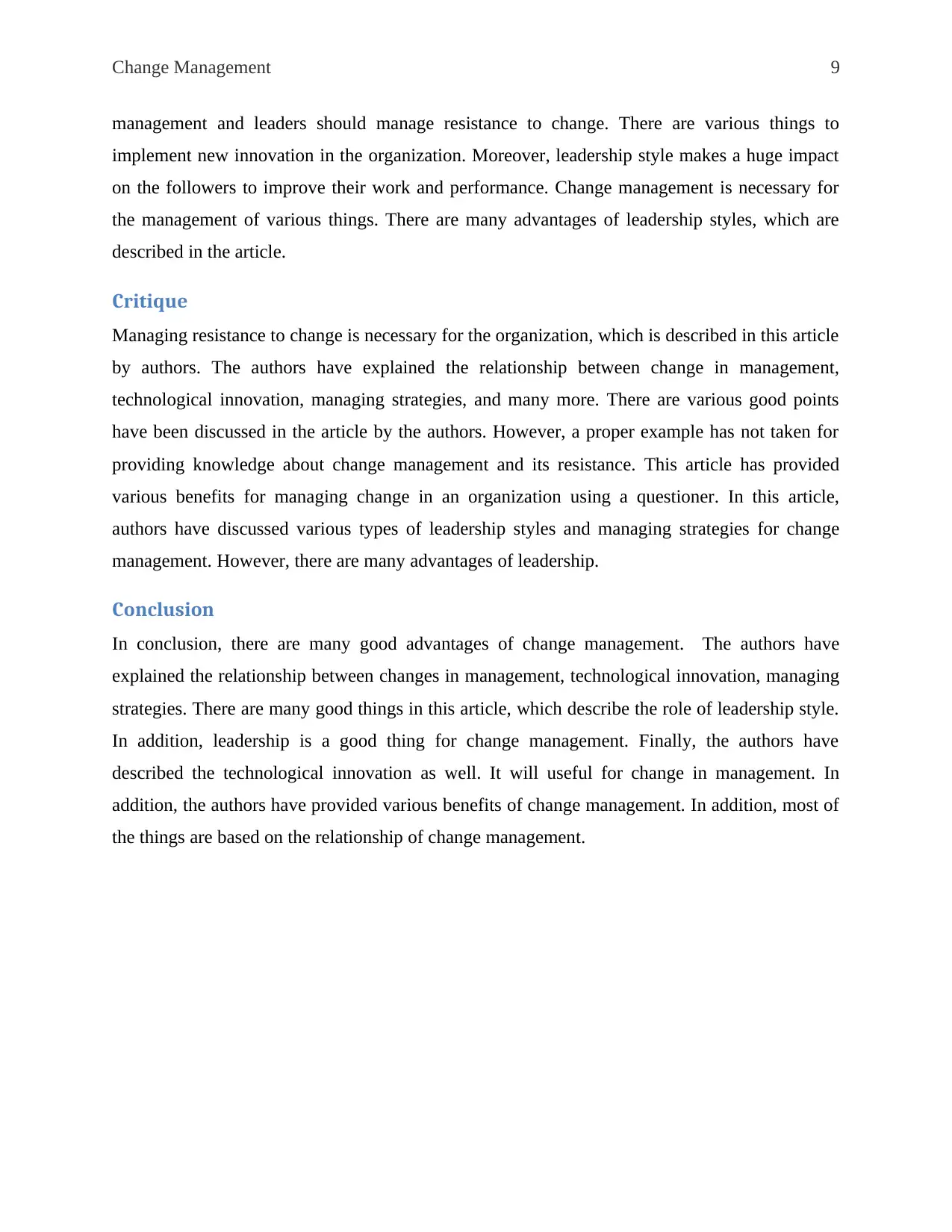
Change Management 9
management and leaders should manage resistance to change. There are various things to
implement new innovation in the organization. Moreover, leadership style makes a huge impact
on the followers to improve their work and performance. Change management is necessary for
the management of various things. There are many advantages of leadership styles, which are
described in the article.
Critique
Managing resistance to change is necessary for the organization, which is described in this article
by authors. The authors have explained the relationship between change in management,
technological innovation, managing strategies, and many more. There are various good points
have been discussed in the article by the authors. However, a proper example has not taken for
providing knowledge about change management and its resistance. This article has provided
various benefits for managing change in an organization using a questioner. In this article,
authors have discussed various types of leadership styles and managing strategies for change
management. However, there are many advantages of leadership.
Conclusion
In conclusion, there are many good advantages of change management. The authors have
explained the relationship between changes in management, technological innovation, managing
strategies. There are many good things in this article, which describe the role of leadership style.
In addition, leadership is a good thing for change management. Finally, the authors have
described the technological innovation as well. It will useful for change in management. In
addition, the authors have provided various benefits of change management. In addition, most of
the things are based on the relationship of change management.
management and leaders should manage resistance to change. There are various things to
implement new innovation in the organization. Moreover, leadership style makes a huge impact
on the followers to improve their work and performance. Change management is necessary for
the management of various things. There are many advantages of leadership styles, which are
described in the article.
Critique
Managing resistance to change is necessary for the organization, which is described in this article
by authors. The authors have explained the relationship between change in management,
technological innovation, managing strategies, and many more. There are various good points
have been discussed in the article by the authors. However, a proper example has not taken for
providing knowledge about change management and its resistance. This article has provided
various benefits for managing change in an organization using a questioner. In this article,
authors have discussed various types of leadership styles and managing strategies for change
management. However, there are many advantages of leadership.
Conclusion
In conclusion, there are many good advantages of change management. The authors have
explained the relationship between changes in management, technological innovation, managing
strategies. There are many good things in this article, which describe the role of leadership style.
In addition, leadership is a good thing for change management. Finally, the authors have
described the technological innovation as well. It will useful for change in management. In
addition, the authors have provided various benefits of change management. In addition, most of
the things are based on the relationship of change management.
Paraphrase This Document
Need a fresh take? Get an instant paraphrase of this document with our AI Paraphraser
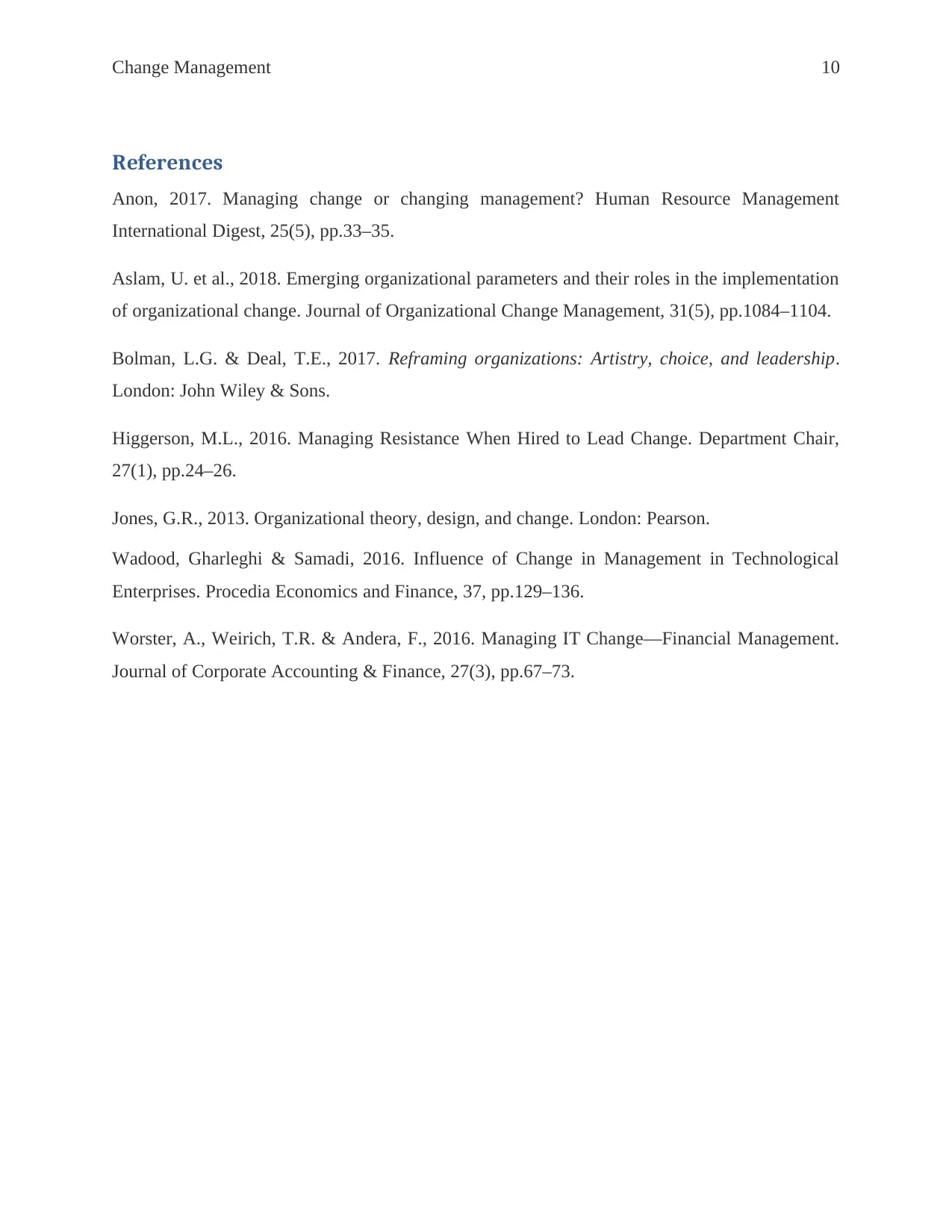
Change Management 10
References
Anon, 2017. Managing change or changing management? Human Resource Management
International Digest, 25(5), pp.33–35.
Aslam, U. et al., 2018. Emerging organizational parameters and their roles in the implementation
of organizational change. Journal of Organizational Change Management, 31(5), pp.1084–1104.
Bolman, L.G. & Deal, T.E., 2017. Reframing organizations: Artistry, choice, and leadership.
London: John Wiley & Sons.
Higgerson, M.L., 2016. Managing Resistance When Hired to Lead Change. Department Chair,
27(1), pp.24–26.
Jones, G.R., 2013. Organizational theory, design, and change. London: Pearson.
Wadood, Gharleghi & Samadi, 2016. Influence of Change in Management in Technological
Enterprises. Procedia Economics and Finance, 37, pp.129–136.
Worster, A., Weirich, T.R. & Andera, F., 2016. Managing IT Change—Financial Management.
Journal of Corporate Accounting & Finance, 27(3), pp.67–73.
References
Anon, 2017. Managing change or changing management? Human Resource Management
International Digest, 25(5), pp.33–35.
Aslam, U. et al., 2018. Emerging organizational parameters and their roles in the implementation
of organizational change. Journal of Organizational Change Management, 31(5), pp.1084–1104.
Bolman, L.G. & Deal, T.E., 2017. Reframing organizations: Artistry, choice, and leadership.
London: John Wiley & Sons.
Higgerson, M.L., 2016. Managing Resistance When Hired to Lead Change. Department Chair,
27(1), pp.24–26.
Jones, G.R., 2013. Organizational theory, design, and change. London: Pearson.
Wadood, Gharleghi & Samadi, 2016. Influence of Change in Management in Technological
Enterprises. Procedia Economics and Finance, 37, pp.129–136.
Worster, A., Weirich, T.R. & Andera, F., 2016. Managing IT Change—Financial Management.
Journal of Corporate Accounting & Finance, 27(3), pp.67–73.
1 out of 11
Related Documents
Your All-in-One AI-Powered Toolkit for Academic Success.
+13062052269
info@desklib.com
Available 24*7 on WhatsApp / Email
![[object Object]](/_next/static/media/star-bottom.7253800d.svg)
Unlock your academic potential
© 2024 | Zucol Services PVT LTD | All rights reserved.





